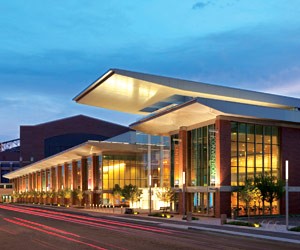In these uncertain economic times, convention centers—much like most businesses—are repeating this mantra: “Find new revenue sources.”
“Convention centers are under immense pressure to boost and sustain occupancy and there’s never been a greater need to find new events and customers,” says Steven Hacker, president of the Dallas-based International Association of Exhibitions and Events (IAEE). “When you consider there are only about 250 megaevents a year of the more than 10,000 that take place in the trade show industry, it puts into perspective that while huge events are major revenue drivers, there are other important pieces to the puzzle.”
To meet the needs of small meetings, groups that attract 1,000 attendees or less, convention centers confront a potpourri of issues such as architectural designs that can’t accommodate multiple small meetings simultaneously, labor costs, catering, pricing and Internet access, to name a few.
Hacker notes that about 40 percent of all exhibitions still take place at hotels, so competition for small meetings at centers is fierce.
Open for Business
With the onslaught of new convention centers and expansions in the past decade, the need to fill space and dates has heightened importance.
“We have six people on our sales staff who are fully dedicated to groups of 150 to 1,000 attendees,” says Michelle Travis, senior vice president of sales for the Indianapolis CVA. “Our convention center expanded last January and our goal is to layer in small and mid-size groups to complement our larger conventions.
“While it offers contiguous space, the unique design separates it into two distinct campuses, enabling us to accommodate smaller groups in spaces where they don’t feel overwhelmed by the expansiveness of the center,” she continues. “Also, there are 4,700 hotel rooms directly connected to the center so smaller groups can move freely between meetings, accommodations and recreation.”
In Milwaukee, home to the 200,000-square-foot Frontier Airlines Center, space limitations have shifted officials’ focus onto small meetings and mid-sized groups. Richard Geyer, president and CEO of the Wisconsin Center District, which operates the center, says small meetings groups are attracted by the building’s scale, its variety of meeting and event venues, advanced technology and a $1.2 million public art collection.
“One of the keys to our success,” Geyer says, “is that we work closely with our hotels to accommodate groups that need additional space. That close relationship helps both of us keep space booked.
“Our high level of fiber optics and Internet access makes the center an extension of their home office for companies,” he adds.
High-end amenities have been a successful draw at the 900,000-square-foot Phoenix Convention Center, which has benefited from offering a 21,000-square-foot conference center within its walls.
“About one-third of our business comes from groups using the conference center,” says Debbie Cotton, interim director for the Phoenix Convention Center and Venues. “The center has top-of-the-line furnishings, exceptional food service and other amenities that make it attractive to a wide variety of groups.”
In San Diego, Andy Mikschl, senior vice president of sales for the San Diego Convention Center Corporation, says small meetings are an important revenue driver for the center.
“We book events that hotels don’t want or can’t take,” Mikschl says. “Our organization has four people on our short-term team who dedicate their efforts to smaller events and meetings, consumer shows and the like.”
Hotels vs. Convention Centers
What’s the difference between staging an event or meeting in a hotel with ample meeting space versus a convention center?
While providing space is no problem at centers, the ambience is often bland compared to an elegantly appointed ballroom at a large, meeting-oriented hotel.
“The bottom line is you typically don’t have to spend as much to make a room look great at a hotel as you would at a center,” says Greg Poulos, president of Bluefin Productions.
However, he adds, planners should tap the power of enlisting suppliers as allies in their work to transform centers into small meeting venues.
“Planners have to be shrewd negotiators with convention centers to make sure they’re getting the best deal, especially if they’re giving up some things that a hotel could provide,” he says.
The Drawbacks
Even if a planner finds a bargain by booking unused space at a convention center, a good deal doesn’t always equate to a good experience.
“One of the downsides of a smaller group meeting in a large convention center is attendees may feel overwhelmed by the unused space around them,” Hacker says. “When you put 100 exhibits and 800 people in a section of a huge building, it can make the event feel tiny and not important. So the space has to fit the size of the event to make it successful.”
Edward Schmidt Jr, a long-time meetings freelance writer based in Orlando, has walked miles of aisles in convention centers across the U.S.






